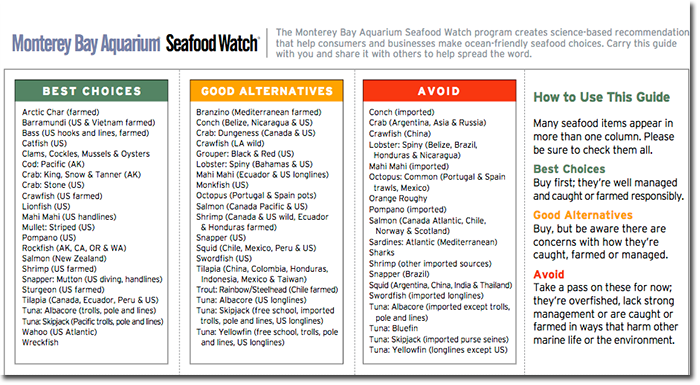We’ve been talking lately about making the best possible choices when shopping for proteins, covering a few principles regarding red meat proteins here and poultry proteins here.
The health benefits of regular seafood consumptions are pretty much indisputable (see here and here for example), with some particular precautions duly noted, and include reduction of chronic inflammation, improved mood and decreased risk of depression, improved cardiovascular and pulmonary health/function, and improved cognitive function across all age groups.
SMASH Your Fish
Two key principles in selecting the best fish choices include selecting fish from colder waters (higher omega-3) and fish lower down the food chain (to minimize concentration of mercury and other contaminants as you move further up the chain).
Remember the SMASH fish five: salmon, mackerel (not king mackerel), anchovies, most sardines, and herring. Smaller fish are most often more economical, and many are canned using quality oils (check to be sure).
Wild-caught fish from remote, pollution free waters should be top on your list (Bristol Bay salmon, we’re thinking about you).
Fish Farms, For the Most Part, Are Not Your Friend
Most farmed fish and shellfish, particularly those raised out of country, are fairly high risk given their exposures to substandard feeds, antibiotic use in pens to address infections caused by compromised water and conditions, are often pesticide-treated given infestations of their tanks, and are often raised in toxic, polluted waters. Many farmed fish and shellfish are even fed artificial coloring agents to tint their flesh more like their wild cousins (common in some Atlantic salmon farms).
There are exceptions to the ‘avoid most farmed fish’ caution, and include domestically raised catfish, barramundi, trout, tanked-farmed coho salmon, crayfish, and most domestically propagated shellfish.
Fish Priorities for Your Plate
Top of the list every time will be the wild-caught, cold-water, oily fish – think the SMASH five; followed by other sustainable, wild-caught fish from pristine waters.
Fish lower on the food chain are your friend for the most part; fish higher on the food chain (i.e. king mackerel, American eel, Chilean sea bass, orange roughy, marlin, shark, swordfish, and some tuna – ahi and big eye) are more prone to bio-accumulation of toxins.
Sustainability of fish stocks has been and will remain a prime concern; for that reason we agree with those who suggest limited consumption of Atlantic cod, halibut, sole, bluefin tuna, and even flounder.
There are several resources available, though the Monterey Bay Aquarium’s Seafood Watch site is probably the most commonly sited resource you need to bookmark and use, and they have a handy pocket guide you can print and carry with you (image cut below).

Fish You’d Never Want to Serve Your Family
Though I was not convinced of this until several years ago, almost all farmed fish from Asia should be avoided given concerns over very lax management of water quality, specifically related to pollution and toxin levels, as well as substandard feeds used.
Another fish to avoid consistently is farmed Atlantic salmon, the species most commonly served by fishmongers and restaurant providers across the country. There’s years of data exposing the travesty of this particular industry, dig around a bit and read more if you’re skeptical.
The Mercury vs. Selenium Debate
We’ve all been cautioned for years about the impressive levels of mercury found in fish stocks, increasing as you move up the food chain, though there’s increasing data available that suggests naturally occurring selenium in fish (high levels except in swordfish and sharks) indeed counteracts many of the concerns regarding mercury in fish. A couple of interesting reads to overview the issue if you’ve not read much on this topic can be found here and here.



[…] impressively bad health implications of some farmed seafood. I’ve addressed the issue in part here over on the Older Bolder Life, and am working on a much more detailed look at sustainable (and […]